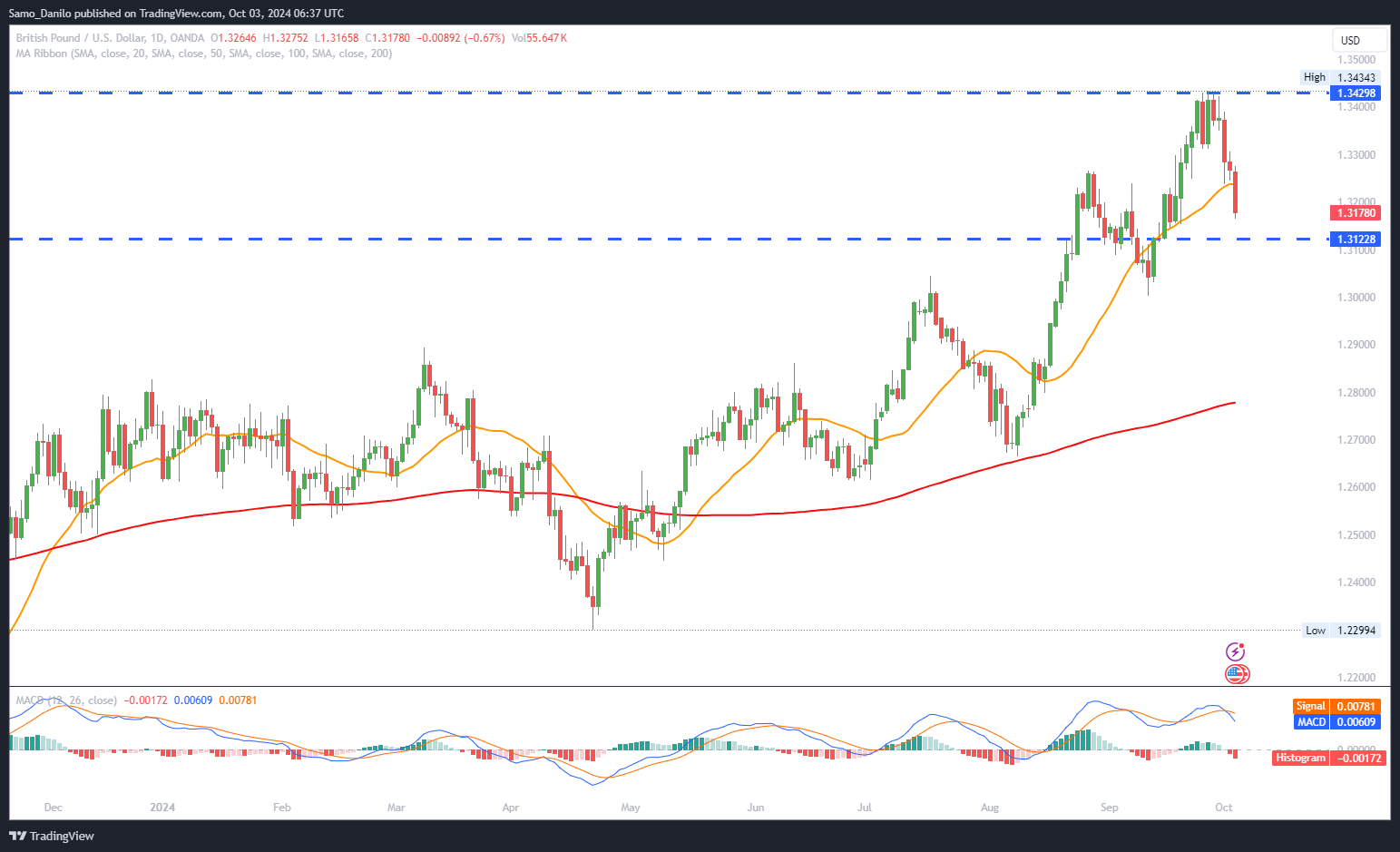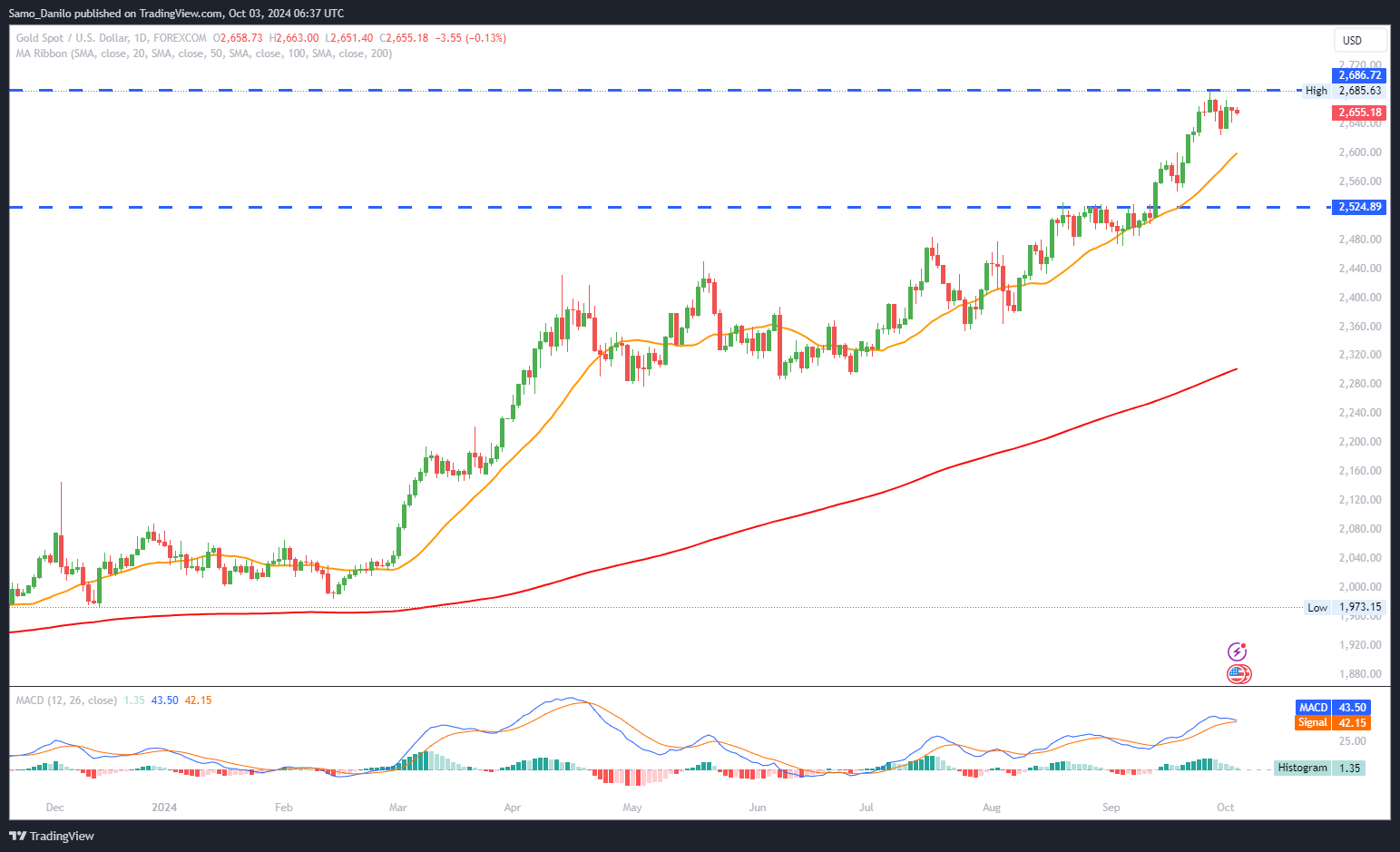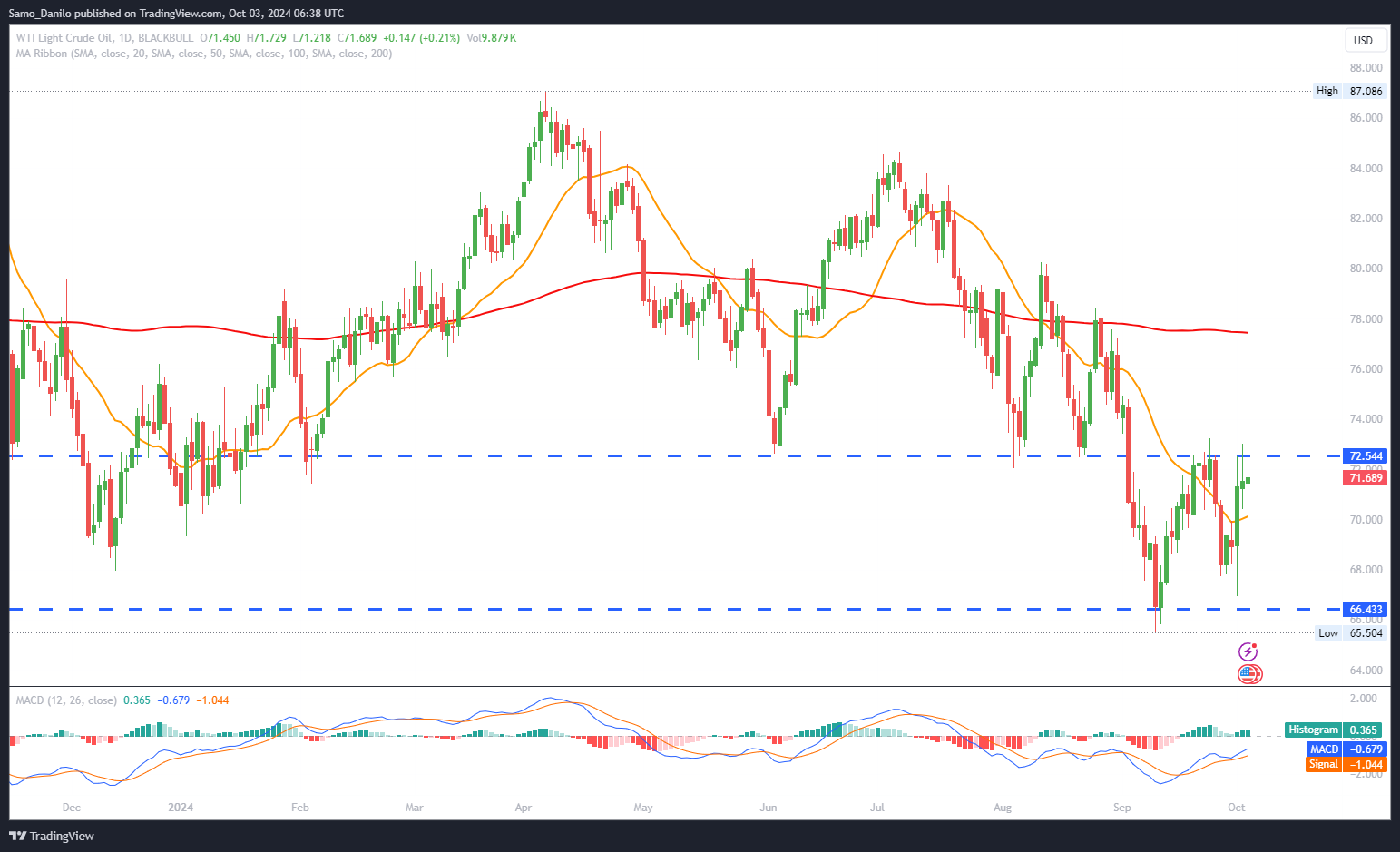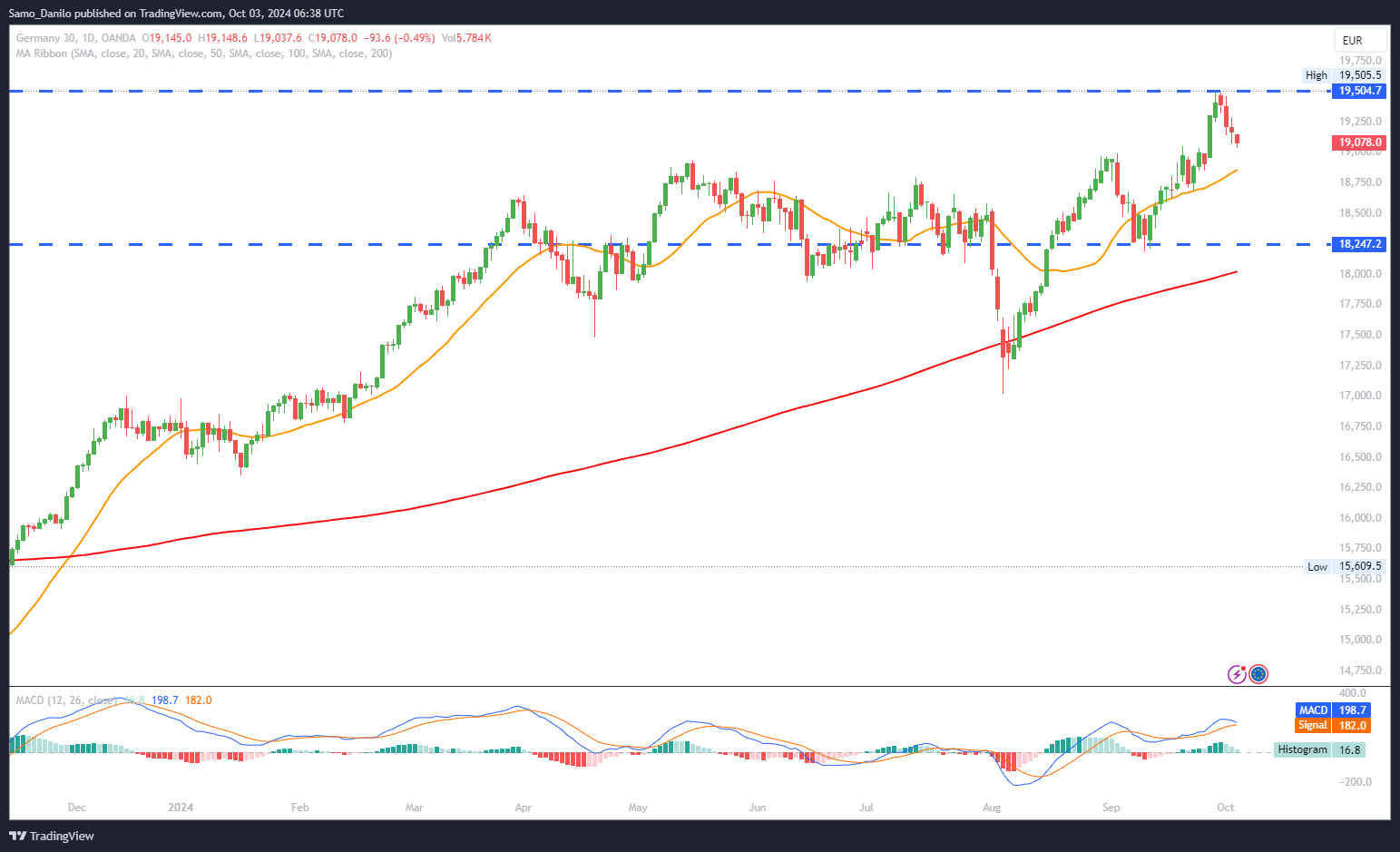EURUSD
- Price Movement: EUR/USD is trending lower, approaching the 1.1000 mark on Thursday morning, marking a three-week low. The pair’s bearish momentum indicates growing selling pressure as traders react to both Eurozone and US economic data.
- Eurozone Unemployment Rate: The Eurozone Unemployment Rate for August remained unchanged at 6.4%, in line with expectations. While this stability suggests resilience in the labour market, it does little to alter the economic outlook, leaving the Euro vulnerable to other factors.
- ECB Caution: ECB Governing Council member Martins Kazaks highlighted increased risks to the economy and emphasized the need for cautious monetary policy adjustments. His comments reflect a more cautious stance from the ECB, potentially hinting at a reluctance to implement additional rate hikes, which could weigh on the Euro.
- US ADP Data: The US ADP Employment Change showed that the private sector added 143K jobs in September, beating the forecast of 120K. This better-than- expected result suggests ongoing strength in the US labour market, supporting the USD and adding pressure on EUR/USD.
- Economic Data Ahead: Market participants are now turning their focus to the upcoming final PMI prints for the Eurozone and the US, as well as the US Weekly Initial Jobless Claims and ISM Services PMI. These releases will provide further clarity on the economic health of both regions, influencing the pair’s near-term trajectory.
Closing statement: EUR/USD is under significant bearish pressure, testing the 1.1000 support level amid solid US employment data and growing concerns over Eurozone economic risks. The pair’s outlook will largely depend on the upcoming data releases, with weak Eurozone PMI prints or strong US numbers likely pushing it below the 1.1000 mark, while any surprises could trigger a temporary rebound.
GBPUSD
- Price Movement: GBP/USD is continuing its downward trend, extending losses toward the 1.3150 mark in early Thursday trading. This ongoing sell-off indicates persistent bearish sentiment, with traders reacting to both US data and the Bank of England’s cautious tone.
- US Employment Data: The ADP US Employment Change report revealed that the private sector added 143,000 jobs in September, surpassing expectations of 120,000. This robust data strengthens the USD, placing additional pressure on GBP/USD as it suggests ongoing resilience in the US labour market.
- BoE’s Cautious Stance: The Bank of England continues to advocate for a cautious approach to lowering interest rates due to persistently high inflation in the services sector and steady economic growth. This cautious stance suggests the BoE may maintain a higher rate environment for longer, which could limit the Pound’s upside potential.
- Financial Outlook: In its quarterly statement, the BoE’s Financial Policy Committee indicated that the risks to the UK’s financial stability remain broadly unchanged since June. This stability does not provide new catalysts for the Pound, keeping it sensitive to external drivers like US economic data.
- Inflation Risks: BoE policymaker Megan Greene warned that a consumption-driven recovery could trigger a new wave of inflation. These concerns add to the uncertainty around the BoE’s policy path, raising questions about whether the central bank will prioritize curbing inflation or supporting growth.
| SMA (20) | Rising |
|
|
| RSI (14) | Slightly Falling |
| |
| MACD (12, 26, 9) | Rising |
|
|
Closing statement: GBP/USD is facing sustained downside pressure, trading near 1.3150 because of strong US employment data and a cautious outlook from the BoE. The pair may continue to trend lower if the USD maintains its strength, while any signs of rising inflationary pressures in the UK could further complicate the BoE’s policy stance and limit the Pound’s ability to recover in the near term.
GOLD
- Price Movement: Gold is trading in a narrow range just below the critical $2,670 resistance level on Thursday, lacking a clear directional catalyst. This sideways movement reflects market uncertainty, as traders await more decisive factors to determine gold’s next move.
- Geopolitical Tensions: Reports of Israel launching retaliatory strikes on central Beirut in response to recent Iranian attacks are heightening geopolitical risks in the Middle East. The possibility of a broader conflict supports safe-haven demand for Gold, but the lack of immediate escalation has limited a strong bullish reaction so far.
- US Employment Data: US ADP private sector employment increased by 143,000 jobs in September, outperforming both the 120,000 forecast and the upwardly revised 103,000 in August. This data suggests ongoing strength in the US labor market, which could put downward pressure on Gold if it bolsters expectations for tighter Fed policy.
- Fed Rate Cut Expectations: The probability of a significant Fed rate cut at the next meeting has dropped to 34%, down from nearly 60% last week, according to CME Group’s FedWatch Tool. Reduced expectations for monetary easing are weighing on gold’s appeal, as higher rates make non-yielding assets like gold less attractive.
- Economic Data Ahead: Traders are now focusing on the upcoming US ISM Services PMI and Weekly Jobless Claims data for additional insights into the health of the US economy and the Fed’s rate path. These releases will be crucial for determining whether gold can break out of its current range.
| SMA (20) | Rising |
|
|
| RSI (14) | Rising |
|
|
| MACD (12, 26, 9) | Rising |
|
|
Closing statement: XAU/USD is trading cautiously below the $2,670 resistance level, caught between intensifying geopolitical tensions and robust US economic data. While safe-haven demand may lend some support amid Middle East concerns, strong US labour data and waning rate cut expectations could keep gold’s upside limited. The upcoming economic data releases will be pivotal in providing the next directional cue, with a break above $2,670 needed to confirm further bullish momentum.
CRUDE OIL
- Price Movement: WTI Crude Oil is trading around $71.00 on Thursday, reflecting a slight upward bias as traders react to the evolving geopolitical landscape. The price movement suggests that supply concerns are currently outweighing other bearish factors, keeping WTI supported.
- Middle East Supply Risks: The recent Iranian missile attack on Israel has raised fears of potential disruptions to oil supply in the Middle East. Traders are closely monitoring the situation, as any escalation could pose significant risks to the region’s output and drive oil prices higher.
- Potential Supply Disruption Impact: According to Citigroup, a significant Israeli attack on Iran’s oil-exporting capabilities could potentially remove 1.5 million barrels per day from the market. This scenario is fueling bullish sentiment as such a supply shock would create substantial upward pressure on global oil prices.
- OPEC’s Capacity to Respond: OPEC is reportedly capable of compensating for the complete loss of Iranian oil supply, but traders are skeptical about its ability to manage the situation if Iran retaliates by targeting its Gulf neighbors’ oil facilities. This uncertainty over OPEC’s ability to stabilize the market adds to the volatility in WTI.
- US Inventory Build Caps Gains: A large build in US crude inventories is limiting the upward momentum. The Energy Information Administration reported a 3.889 million barrel increase in stockpiles for the week ending September 27, suggesting ample domestic supply, which tempers the bullish impact of Middle East concerns.
| SMA (20) | Falling |
|
|
| RSI (14) | Slightly Rising |
| |
| MACD (12, 26, 9) | Slightly Rising |
|
Closing statement: WTI Crude Oil is currently trading around $71.00, buoyed by supply risk fears stemming from the Iran-Israel conflict. While geopolitical tensions are driving prices higher, the large build in US inventories is capping gains. The outlook remains highly sensitive to developments in the Middle East, with any escalation likely to propel prices sharply higher, while stabilization in the region or further inventory builds could lead to a pullback.
DAX
- Auto Sector Weakness: Auto stocks on the DAX continued their decline for the third consecutive day on Wednesday, pressured by ongoing concerns over lower profit forecasts. The sector's downturn reflects a broader risk-off sentiment amid uncertainty surrounding the Fed’s rate path and geopolitical tensions in the Middle East.
- Eurozone Labor Market: The Eurozone unemployment rate held steady at 6.4% in August, maintaining expectations for a potential rate cut by the ECB in October. The stable labor market suggests that the ECB might have room to adopt more accommodative policies, potentially supporting DAX-listed stocks in the medium term.
- Services PMIs: Preliminary September Services PMIs for both Germany and the broader Eurozone showed significant declines, with the Eurozone HCOB Services PMI falling to 50.5 from 52.9 in August, and Germany’s PMI also reflecting contraction. These weak figures are heightening concerns over a potential recession in Germany, weighing on overall market sentiment.
- US Employment Data: Strong US ADP employment data, showing a 143,000 job increase in September, has lessened expectations of a large Fed rate cut in November. This has led to reduced demand for riskier assets, including DAX stocks, as traders anticipate a more hawkish stance from the Fed.
- US Data Ahead: Market participants are turning their attention to the upcoming US Initial Jobless Claims and ISM Services PMI data on Thursday. These releases could further influence demand for DAX-listed stocks, especially if they provide additional signals about the Fed’s policy direction.
| SMA (20) | Rising |
|
|
| RSI (14) | Slightly Rising |
| |
| MACD (12, 26, 9) | Rising |
|
|
Closing statement: The DAX is facing headwinds from continued weakness in the auto sector and deteriorating economic data, particularly weak Services PMIs that suggest a deepening recession risk in Germany. With stable Eurozone unemployment rates supporting expectations for an ECB rate cut, the index’s outlook remains uncertain. The focus will now shift to key US data releases, which could either exacerbate or alleviate the bearish sentiment depending on their impact on the Fed’s rate path.




